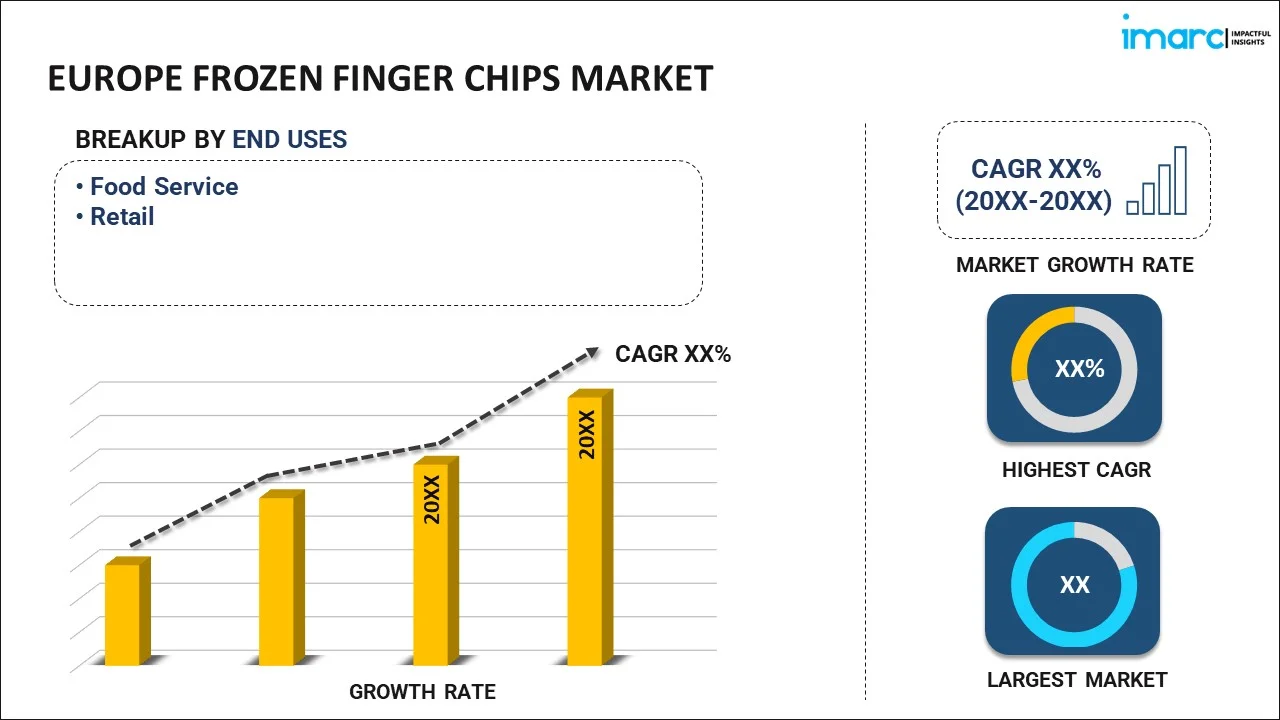
Europe Frozen Finger Chips Market Report by End Use (Food Service, Retail), and Country 2025-2033
Market Overview:
The Europe frozen finger chips market size reached USD 7.4 Billion in 2024. Looking forward, IMARC Group expects the market to reach USD 13.8 Billion by 2033, exhibiting a growth rate (CAGR) of 6.84% during 2025-2033.
|
Report Attribute
|
Key Statistics
|
|---|---|
|
Base Year
|
2024
|
|
Forecast Years
|
2025-2033
|
|
Historical Years
|
2019-2024
|
|
Market Size in 2024
|
USD 7.4 Billion |
|
Market Forecast in 2033
|
USD 13.8 Billion |
| Market Growth Rate 2025-2033 | 6.84% |
Frozen finger chips are thin potato strips that are stored at extremely low temperatures and are either baked or fried before consumption. They are commonly available in a wide variety of shapes, sizes and salted and unsalted flavors and are manufactured using potatoes, dextrose, sodium acid pyrophosphate, hydrogenated soybean oil, dimethylpolysiloxane and citric acid. Frozen finger chips are thawed, served hot and are widely consumed in various cuisines as snacks or as side dishes. They are ready-to-cook and offer enhanced ease of storage and longer shelf life.
Europe Frozen Finger Chips Market Trends:
The growth in the Europe frozen finger chips market can be attributed to the increasing demand for convenience food products among the masses. Due to the hectic schedules and busy lifestyles, consumers are widely adopting frozen food products that require minimal time to prepare. Additionally, the increasing product utilization in the foodservice industry is positively impacting the market growth. Frozen finger chips are extensively used and served in cafes, restaurants and fast-food chains to provide a wide variety of dishes to the consumers. Moreover, various product innovations, such as the launch of finger chips in shoestring, curly, waffle, crinkle and wedge cut variants, are favoring the market growth. Product manufacturers are also launching variants with low sodium and carbohydrate content to meet the requirements of the health-conscious individuals. Other factors, including the strong expenditure capacities of consumers, along with the convenient product availability through e-commerce platforms, are creating a positive outlook for the market across the region.
Key Market Segmentation:
IMARC Group provides an analysis of the key trends in each segment of the Europe frozen finger chips market report, along with forecasts at the regional and country levels from 2025-2033. Our report has categorized the market based on end use.
Breakup by End Use:

- Food Service
- Retail
Breakup by Country:
- Germany
- France
- United Kingdom
- Italy
- Spain
- Others
Competitive Landscape:
The competitive landscape of the industry has also been examined along with the profiles of the key players.
Report Coverage:
| Report Features | Details |
|---|---|
| Base Year of the Analysis | 2024 |
| Historical Period | 2019-2024 |
| Forecast Period | 2025-2033 |
| Units | Billion USD |
| Segment Coverage | End Use, Country |
| Countries Covered | Germany, France, United Kingdom, Italy, Spain, Others |
| Customization Scope | 10% Free Customization |
| Post-Sale Analyst Support | 10-12 Weeks |
| Delivery Format | PDF and Excel through Email (We can also provide the editable version of the report in PPT/Word format on special request) |
Key Questions Answered in This Report
The Europe frozen finger chips market was valued at USD 7.4 Billion in 2024.
We expect the Europe frozen finger chips market to exhibit a CAGR of 6.84% during 2025-2033.
The increasing demand for convenient, easy-to-prepare, and Ready-To-Cook (RTC) food items that require minimal preparation time, along with the introduction of finger chips in shoestring, curly, waffle, crinkle, and wedge cut variants, is primarily driving the Europe frozen finger chips market.
The sudden outbreak of the COVID-19 pandemic has led to the changing consumer inclination from conventional brick-and-mortar distribution channels towards online retail platforms for the purchase of frozen finger chips across several European nations.
Based on the end use, the Europe frozen finger chips market can be bifurcated into food service and retail. Currently, food service holds the largest market share.
On a regional level, the market has been classified into Germany, France, United Kingdom, Italy, Spain, and others, where Germany currently dominates the Europe frozen finger chips market.
Need more help?
- Speak to our experienced analysts for insights on the current market scenarios.
- Include additional segments and countries to customize the report as per your requirement.
- Gain an unparalleled competitive advantage in your domain by understanding how to utilize the report and positively impacting your operations and revenue.
- For further assistance, please connect with our analysts.
 Request Customization
Request Customization
 Speak to an Analyst
Speak to an Analyst
 Request Brochure
Request Brochure
 Inquire Before Buying
Inquire Before Buying




.webp)




.webp)












